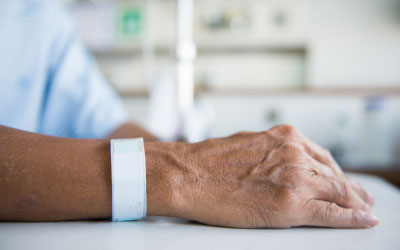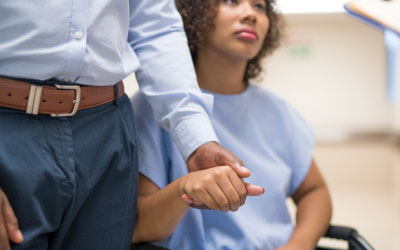B-cell Acute Lymphoblastic Leukemia
B-cell acute lymphoblastic leukemia, or B-ALL, is a bone marrow and blood cancer.
B-ALL occurs at any age but more commonly in children. With treatment, children have very high cure rates.
What is B-cell acute lymphoblastic leukemia?
B-cell acute lymphoblastic leukemia is a rare blood cancer affecting B-cell development. B-cells are white blood cells made in the bone marrow (the soft inner part of bones). They help the body to fight off infections.
The term “acute” means the sudden and severe onset of a disorder that can progress quickly. In B-ALL, the bone marrow makes too many abnormal, immature B-cells called lymphoblasts.
The abnormal B-cells build up in the bone marrow and spill over into the blood. This allows them to spread to other areas of the body quickly.
Organs such as the lymph nodes, liver, and spleen may swell as abnormal B-cells build up in other tissues. B-ALL may also spread to the brain, spinal cord, and testicles.
B-cell acute lymphoblastic leukemia facts and stats
- B-ALL is the most common type of childhood leukemia.
- Around 75% of all B-ALL cases affect children younger than six.
- Around 75% of adults with ALL have the B-ALL subtype.
- Around 85% of children with B-ALL stay cancer free after five years.
- The five-year survival rate for B-ALL is above 90% in children and around 40% in adults over age 20.
- B-cell acute lymphoblastic leukemia is the most common subtype of acute lymphoblastic leukemia (ALL).
Causes and risk factors for B-cell acute lymphoblastic leukemia
Researchers think changes (mutations) in genes regulating B-cell development cause B-ALL. The cause of these genetic mutations is unknown.
Risk of developing B-ALL increases in children with:
- Family history of leukemia, especially in other siblings
- Genetic conditions, such as Down syndrome
- Previous exposure to X-rays, radiation, or chemotherapy
- Suppressed immune systems, usually from treatments following organ transplantation
Signs and symptoms of B-cell acute lymphoblastic leukemia
Signs and symptoms of B-cell acute lymphoblastic leukemia may include:
- Decreased appetite/unintentional weight loss
- Difficulty breathing
- Easy bruising/excessive bleeding (especially of the nose and gums)
- Fatigue
- Pain in joints, bones, and abdomen (abdominal pain due to enlarged liver or spleen)
- Recurrent fevers/frequent infections
- Swelling of lymph nodes
Diagnosing B-cell acute lymphoblastic leukemia
To diagnose B-ALL, your doctor performs a physical exam and asks about your medical history. Tests may include:
- Blood tests: These tests count the number of platelets, white blood cells, and red blood cells in a sample of your blood. Doctors also use blood tests to analyze liver and kidney function and detect signs of inflammation and infection.
- Bone marrow aspiration or biopsy: Your doctor uses a thin, hollow needle to remove small samples of bone marrow or bone tissue for analysis. This is the most common and reliable method for B-ALL diagnosis.
- Imaging: Imaging determines cancer severity and locates affected lymph nodes and tumors. It also detects enlarged organs, such as the liver or spleen. Imaging may include:
- Chest X-rays
- Computed tomography (CT) scans
- Echocardiograms
- Magnetic resonance imaging (MRI) scans
- Positron emission tomography (PET) scans
- Ultrasounds (US)
- Lumbar puncture (spinal tap): Your doctor uses a needle to remove a small amount of cerebrospinal fluid (CSF) from near your spinal cord. CSF surrounds and protects your brain and spinal cord. Results show whether the cancer has spread into this fluid.
- Genetic testing: This test detects abnormal genes or chromosomes and guides your doctor’s treatment recommendation.
Treatments for B-cell acute lymphoblastic leukemia
Treatment depends on your B-ALL subtype, current symptoms, response to treatment, and overall health. Other health conditions that you have might affect treatment options.
Treatment options for B-ALL include:
- Chemotherapy: Chemotherapy drugs kill cancer cells. You receive this treatment either in pill form or as injections into a vein, muscle, underneath the skin, or into the fluid around the spinal cord (intrathecal). Children often tolerate higher doses of chemotherapy better than adults.
- Radiation: Doctors use focused beams of energy to destroy cancer cells while reducing harm to healthy tissues. Radiation may treat B-ALL in the testicles, brain, or spinal cord.
- Targeted therapy: Targeted drugs stop the growth of cancer cells or kill them while minimizing harm to nearby healthy tissues.
- Stem cell transplant (bone marrow transplant): Your doctor may replace unhealthy stem cells (blood-forming cells in the bone marrow) with healthy stem cells. Replacement stem cells may come from a donor or your own healthy cells.
- CAR T-cell therapy: This type of therapy improves your own immune response to fight cancer. Doctors remove white blood cells called T-cells from your blood and genetically engineer them to target cancer cells more efficiently. They then inject these newly altered T-cells back into your blood to start the treatment.
- Clinical trials: Studies at specific medical centers may give eligible patients access to promising treatments currently under development. These treatments usually are not widely available.
- Supportive therapies: Supportive care may replace or supplement more intensive treatments, such as chemotherapy. They can provide relief from cancer symptoms or side effects from cancer treatments. Supportive therapies may include:
- Antibiotics to treat recurrent infections
- Blood transfusions to treat low platelet and red blood cell levels
- Counseling
- Diet
- Meditation and relaxation exercises
- Pain management
- Physical exercise
Helpful resources
Support can make a significant difference when you face a cancer diagnosis. You can connect with others who understand these challenges through our peer support programs. We offer an online support community and a mentoring program. We also have a directory of resources to help patients, families, and caregivers.



